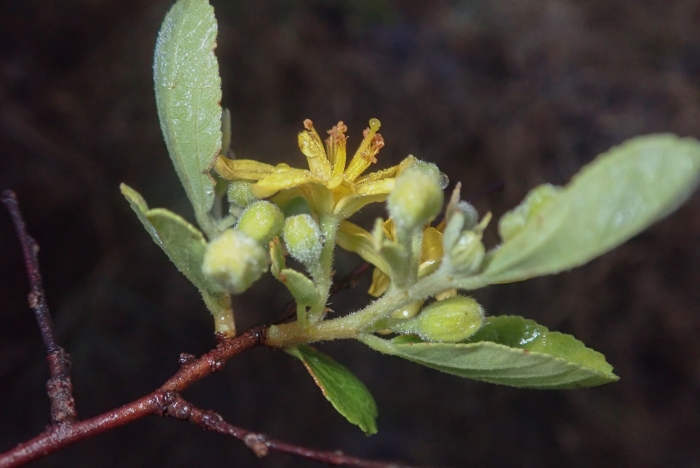Bastard Brandy Bush
(Grewia bicolor)
Bastard Brandy Bush (Grewia bicolor)
/
/

Robert Taylor
CC BY 4.0
Image By:
Robert Taylor
Recorded By:
Copyright:
CC BY 4.0
Copyright Notice:
Photo by: Robert Taylor | License Type: CC BY 4.0 | License URL: http://creativecommons.org/licenses/by/4.0/ | Rights Holder: Robert Taylor | Publisher: iNaturalist | Date Created: 2021-04-30T06:47:01-07:00 |























Estimated Native Range
Summary
Grewia bicolor, commonly known as bastard brandy bush or white-leaved raisin, is a deciduous shrub native to a variety of habitats including savannas, woodlands, and bushveld in sub-Saharan Africa, as well as arid regions of Yemen and Oman, extending to the Indian subcontinent. It typically grows to a height of 2-8 meters with a similar spread, and features a dense, rounded to spreading form. The leaves are distinctive with a two-toned appearance, being dark green above and white to pale green below. Small, yellow to orange flowers bloom in clusters, mainly during the summer months, followed by edible, sweet, and fleshy fruits that resemble raisins.
The bastard brandy bush is valued for its drought tolerance and ability to thrive in a range of soil types, from sandy to loamy and well-drained. It is often used in reforestation projects and as a living fence in agricultural landscapes due to its hardiness and the protection it offers against soil erosion. The plant’s fruits are not only a vital food source for wildlife but also consumed by humans, and its fibrous bark is utilized in making ropes and textiles. In cultivation, it requires minimal care once established, making it an excellent choice for xeriscaping. However, it may be susceptible to root rot in poorly drained soils and should be monitored for pests such as caterpillars that can defoliate the plant.CC BY-SA 4.0
The bastard brandy bush is valued for its drought tolerance and ability to thrive in a range of soil types, from sandy to loamy and well-drained. It is often used in reforestation projects and as a living fence in agricultural landscapes due to its hardiness and the protection it offers against soil erosion. The plant’s fruits are not only a vital food source for wildlife but also consumed by humans, and its fibrous bark is utilized in making ropes and textiles. In cultivation, it requires minimal care once established, making it an excellent choice for xeriscaping. However, it may be susceptible to root rot in poorly drained soils and should be monitored for pests such as caterpillars that can defoliate the plant.CC BY-SA 4.0
Plant Description
- Plant Type: Shrub, Tree
- Height: 9-15 feet
- Width: 6-10 feet
- Growth Rate: Moderate
- Flower Color: Yellow, Green
- Flowering Season: Spring, Summer
- Leaf Retention: Evergreen
Growth Requirements
- Sun: Full Sun
- Water: Low
- Drainage: Medium, Fast
Common Uses
Bird Garden, Drought Tolerant, Edible*Disclaimer: Easyscape's listed plant edibility is for informational use. Always verify the safety and proper identification of any plant before consumption., Low Maintenance
Natural Habitat
Savannas, woodlands, and bushveld
Other Names
Common Names: White Crossberry, Two-coloured grewia
Scientific Names: , Grewia bicolor, Grewia araria, Grewia arborea, Grewia arborea, Grewia bicolor var. dinteri, Grewia cinerea, Grewia cubensis, Grewia dinteri, Grewia discolor
GBIF Accepted Name: